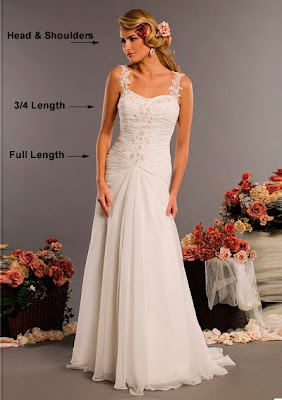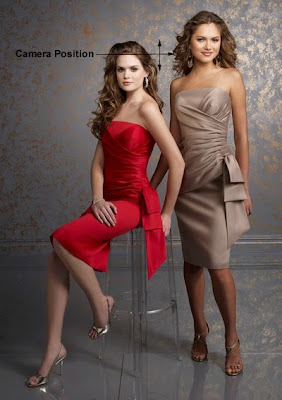 |
| Photo by: Xubangwen |
Camera Perspective
In classic portraiture, the general rule is to retain an accurate likeness of a subject and to do that it is important to place the camera where it will record an absolutely normal view of the face. The position from where the camera will record a normal view of the face is referred to as a normal camera perspective. When a portrait is shot with a normal camera perspective all components of the subject’s facial features will be in perfect balance with each other and none of the features will appear distorted.
So attaining the right camera perspective means the photographer should know exactly where to position the camera and depending on how the subject is positioned for the portrait; the height of the camera should also be adjusted to record a normal view of the face.
It is possible to alter the shape and form of the subject’s facial structure substantially, by varying the perspective, to capture a recognizable likeness of a subject, avoid using an overly-high or overly-low camera perspective. But on occasions where you think the subject’s appearance may be enhanced by a slight change of camera perspective it is perfectly fine to digress from the normal perspective.
For example, when photographing a subject with a short, turned-up nose using a slightly higher camera perspective will actually enhance the subject’s appearance, without altering the subject’s likeness. Similarly when photographing a subject with a long nose, slightly lowering the camera perspective will help enhance the subject’s appearance.
In general photography, altering camera perspective is used for creative effects but in classic portraiture digressing from normal perspective is rare.
Camera Positions for Normal Perspective in Close-up poses: Head and Shoulders Portraits
In the case of close up poses like the head and shoulders portraits the camera position is based in relation to the subject’s face.
Leave your camera on a tripod and complete the pose. Once you are satisfied with the pose, frame your shot carefully; make sure that your sensor is parallel to your subject’s face to establish a normal camera perspective. Once you have done this you will notice that your camera is positioned either at the same height as of your subject’s eyes or slightly above. This is the correct camera height for that pose and will record an undistorted likeness of the face.
Head and Shoulders pose with two subjects:
 |
| Photo by: Xubangwen |
When two subjects are arranged in a head and shoulder pose, their faces are usually placed on different levels to create an interesting composition. The height relationship between the two faces may vary from pose to pose but ultimately both should appear in the portrait as viewed from a normal camera perspective.
To do that, position the camera at a height averaging between the two faces. Now, adjust the head of each subject up or down as needed, to relate the normal undistorted view of each face to the camera.
Camera Positions for Normal Perspective in Mid-distance poses: Three Quarter Length Portraits
We have seen that in head and shoulders portraits the camera height is related to the subject’s face, but in three quarter length portraits it is exactly the opposite. Here the camera height is based on how the body is posed.
As in head and shoulders portraits it is important to make sure that you have aligned the sensor parallel to your subject. In this case the subject’s body and not the face. When you have properly farmed your subject and have aligned the sensor parallel to your subject you’ll find that your camera is now the same height as your subject’s chest. This is the correct camera height for that pose and will record an un-distorted likeness of the person.
But that creates a new problem, when you position the camera at a required height needed to record an un-distorted view of a three-quarter length body composition, the facial angle you intend to photograph may not be accurately related to this camera position. In that case, to complete the pose you must adjust the position of the subject‘s head, bringing the desired facial angle to the camera. This procedure is applied to all three-quarter length portraits, in seated or standing arrangements.
Camera Positions for Normal Perspective in Full Length poses: Full Length Portraits
For full length portraits with the subjects seated the procedure is the same as for mid distance poses, only difference is that when framing the subject’s entire figure is included. Sensor is kept parallel to the body and the pose is completed by tilting the head to bring the normal view of the face to the camera.
In standing full length poses, the camera must be positioned where the film plane will remain parallel with the standing figure. To do this the camera will have to be positioned at the same height as that of the subject’s waist. Remember to complete the pose by adjusting the subject’s head to relate a normal facial view to the camera.
It is important that the camera is kept in an absolutely straight upright position, without tilting up or down to achieve a normal, undistorted portrayal of the figure. The reason for that is to avoid distorting the figure. If the camera is tilted town it will make the subject appear foreshortened and if the camera is tilted up it will make the subject look elongated. Another reason to avoid tilting the camera is that full length portraiture, particularly on location, often includes surrounding objects, such as windows, doors, drapes, book shelves, etc. Tilting the camera causes unpleasant distortion of vertical lines. Keeping the camera parallel with the surrounding area eliminates that problem.
Full length poses of groups:
For photographing full length poses of groups position the camera at a height which will be the general middle of the overall group. This will establishes a basic camera perspective for recording the figures and faces looking normally proportioned and undistorted. In group portraits, especially full length group arrangements the faces are relatively small in the frame so it is not necessary to relate each face to the camera position.
How High to Position Your Camera for a normal camera perspective – Quick Reference
1. Close-up poses: Head and Shoulders Portraits:
Camera position is related to the subject’s face. Position the camera at the subject’s eye level or slightly above, make sure to achieve a parallel between the facial plane and the sensor plane.
2. Mid-distance poses: Three quarter length Portraits:
For seated or standing subjects the camera position is related to the subject’s figure. Position the camera at the subject’s chest level and adjust the subject’s face to relate to the camera.
3. Full length poses: Subjects Seated:
When photographing a full length pose with the subject seated, the same principles apply as for three quarter length poses, detailed just above.
4. Full length Standing poses:
Place the camera at the subject’s waist level. Keep the camera in a straight upright position without tilting up or down. Subject’s face must be related to the camera height.
Post a Comment